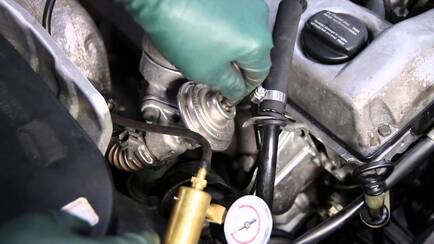Part 2 – Unsung Hero or Nefarious Villain? By P Sanchez In the previous installment of this two part blog, we discussed the often poorly understood (or under-appreciated) emissions control device called the Exhaust Gas Re-circulation system and how it not only helps curb tailpipe pollutants but also provides additional protection from engine knock. We continue acquainting with the EGR system and see how filling cylinders with burnt gas can actually help the engine run better. We’ll also touch on common problems that come upon the EGR (including problems that come about messing with it) and other cool related automotive tidbits. Let’s dive in! Pumping Action
Another benefit of the EGR system is with mitigating the effects of pumping lost. Pumping loses happen when the throttle is closed or barely open (like taking your foot off the gas pedal) but the piston continues to draw in air during intake strokes, creating partial vacuums that the engine has to additionally work against. Left on its own, the pressures involved are estimated to reach up to 30 psi per cylinder per intake. To put that in perspective, that’s about the same amount of air pressure needed to inflate a tire. In this scenario, the EGR system allows a controlled amount of exhaust gases to fill the cylinders instead. Blowing Smoke Up Yours All things considered, the EGR system is a pretty straight forward system in a car. Basically, it’s a tube with one end opening at the exhaust manifold and the other at the intake manifold. An electronically controlled valve opens or shuts the re-entry of exhaust gases to the intake, depending on driving conditions. Some systems would have special sensors to monitor the exhaust gas being recirculated, others would even have provisions to cool the exhaust (like a radiator) before it’s introduced into the intake, thereby preserving intake air density while treating it. Since EGR systems facilitate exhaust gases, carbon build-up and clogging along its constricted channels is an inevitable course as an engine age. How bad and how soon depends on a lot of factors, from the design of the EGR system and the type of engine itself to the quality of fuel used to run the engine. Rough idling, getting a check engine light and failing a tailpipe emission test are symptoms of a bad EGR system. More precisely, mechanics can tell a clogged EGR system through a specific error code report from an OBD scan. One of the more common things to go bad about the EGR system is the EGR valve as prolonged exposure to exhaust gases can break it. Fortunately, the valve is often accessible from under the hood and easy to replace by a qualified mechanic. What’s not convenient is cleaning the EGR system or its effect on the intake manifold. Diesel engines are notorious for this. The carbon build-up can get so thick that it can start choking the engine. In these scenarios, the only way to clean carbon build-up in the intake manifold requires opening and dismantling of the head assembly and using either a chemical bath to dissolve-away the crud or “sandblasting” the inner metal surfaces. EGR, Schmigee-ar! A few misguided tuning enthusiasts will go as far as removing the EGR system from their engines in the thought of avoiding the exhaust dilution in the intake will result in generating a little more power. Even if they get away with it without triggering the check-engine light or worrying about passing emission regulations, the likelier outcome is lower band power lost, rough idling and increase risk of engine knock on the red line. On another note, some engines systems have been successful at addressing NOx and knock reduction with less dependence (if any at all) on employing an EGR system. Some engines reduce overall cylinder volume (and in effect, reduce pressure or pumping losses) through variable valve timing, and knock avoidance through direct fuel injection. The Final Stroke The EGR system is part of what makes a modern engine perform at its most efficient and we have science, research and a lot of clever engineering to thank for. Do you agree with the author’s point? Or is it just a lot of hot gas? Like or leave your comments below.
2 Comments
10/19/2019 01:48:43 pm
sunroof tamiri,sunroof tamiri istanbul,mini onarım Teşvikiye Garaj, ustalığı teknoloji ile birleştiren özel oto servisidir. Hem kurumsal hem de bireysel müşterilerine profesyonel servis hizmetini ekonomik fiyatlarla sunar. Teşvikiye Garaj güvencesiyle araçlarınız emin ellerde.. Auto King ® | Mini Onarım | Sunroof ve Dolu Hasar Tamiri | Tesvikiye Garaj
Reply
5/2/2023 11:50:17 am
It explains about Exhaust Gas Re-circulation system well. Thank you for your effort to put detailed information about this.
Reply
Leave a Reply. |
AuthorSmith's Auto Repair serves Dayton, Ohio and the surrounding communities using digital inspection service for all its customers ArchivesCategories |
 RSS Feed
RSS Feed